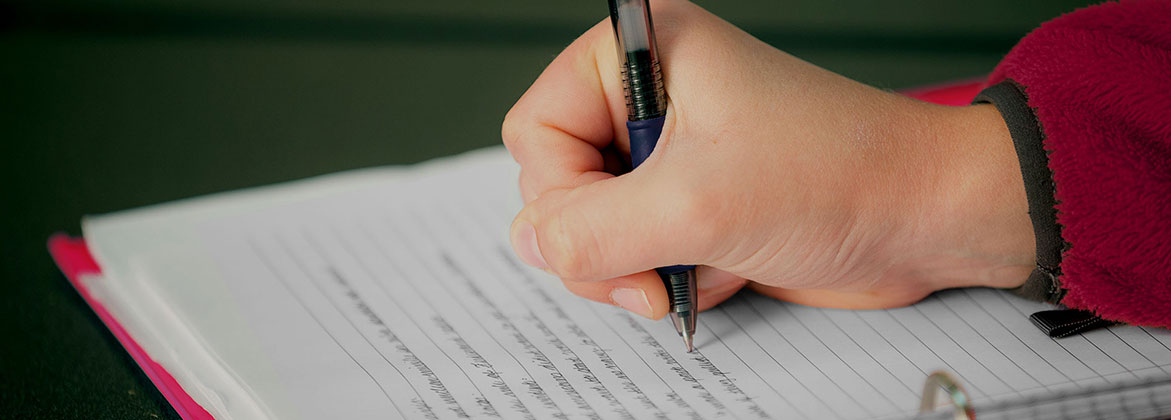Sentence Structure
A noun is a word that describes a person, place, or thing.
Examples:
- dog, cat, freedom, Dallas, Mr. Brown
Nouns can be common or proper; proper nouns require a capital letter.
Examples:
- Common: book, apple, crayon
- Proper: Houston Mr. Brown, the Bible
Nouns can be singular or plural.
Examples:
- Singular: bird, road, wish, army, crisis, Mrs.Brown
Making a noun plural usually involves adding an "s" or "es" to the singular noun, but there are many exceptions.
Examples:
- Plural: birds, roads, wishes, armies, crises, the Browns.
Pronouns are words that take the place of nouns.
Example:
- The student said that the student's paper was a mess, and the student did not know how to fix it, which explains why the student came to the Writing Center.
That seems repetitive. Pronouns enable one to write...
- The student said that his paper was a mess, and he did not know how to fix it, which explains why he came to the Writing Center.
Common Pronouns
Singular
First Person:
Second Person:
Third Person:
Third Person Neutral:
Plural
First Person:
Second Person:
Third Person
*Subjective pronouns are used as subject and objective pronouns are used as objects of sentences or prepositions.
Subjective* Objective*
I me
you you
she, he her, him
it, one it, one
we us
you you
they them
Verbs are words that describe an action.
Examples:
- run, play, read, do, be, are, sing
Like nouns, verbs can be singular or plural.
Examples:
- Singular: He runs.
- Plural: They run.
Verbs indicate the tense of the sentence.
Examples:
- The present tense describes actions that happen now.
- Ex: He walks.
- The past tense describes actions that happened in the past.
- Ex: He walked.
- The future tense describes an action that will occur in the future.
- Ex: He will walk.
- The progressive tense allows the writer to discuss an ongoing action, using the auxiliary verb be and the present participle of the verb (verb + ing).
- Ex: He is walking.
- The perfect tense allows the writer to discuss a completed action, using the auxiliary verb, have and the past participle of the verb (verb + ed).
- Ex: He has walked.
- The perfect progressive tense allows the writer to discuss an ongoing action that has been completed, using the auxiliary verbs have, be, and the present participle of the verb.
- Ex: He has been walking.
Verbs also indicate mood:
- The indicative mood makes statements of fact and asks direct questions. This is the most frequently used tense.
The imperative mood expresses an order or request.
Examples:
- Be quiet!
- Do as you are told.
The subjective mood expresses desire, doubt, suggestions, wishes, and conditional ("if") statements.
Examples:
- I wish they would be quiet.
- This may be possible.
- It would be better if it was not raining.
Adjectives are words that describe a noun. The descriptive adjectives provide more interesting sentences with greater detail.
Examples:
- brown bear, three dimes, cold water, that story, expressive art
Adjectives also show possession.
Examples:
- Sam's book, Lauren's chair, my headache
In English, there are three article adjectives: a, an and the. "The" is the definite article, meaning that it specifies which one.
Examples:
- a bird, an ostrich, the bird
Adverbs are words that modify an adjective, a verb, or another adverb. Many adverbs end in -ly.
Examples:
- He quickly ran across the street.
- Quickly is modifying ran, indicating a time frame for the action.
- They are extremely happy.
- Extremely is modifying the adjective happy.
- They run very quickly.
- Very is modifying quickly, another adverb.
A preposition is a word that connects a noun to the rest of the sentence.
Prepositions can indicate place, direction, or relationships.
Some preposition examples:
- about, above, across, along, as, behind, beneath, below, beside, by, despite, except, from, in, of, on, out, over, through, to, under, with, without
Object of Prepositions
Prepositions need an object to connect to the rest of the sentence. The noun and its modifiers make the object of the proposition.
Examples:
- The boy ran up the hill.
- I went to the store.
- We passed through the scary forest on a dark night.
When there is a preposition and object of the preposition, there is a prepositional phrase.
Examples:
- up the hill; to the store; through the scary forest; on a dark night
A sentence has two parts: the subject and the verb.
Examples:
- The child.
- What about the child? What is he doing? This is an incomplete sentence.
- Reads.
- Who reads? Who is performing this action? This is also an incomplete sentence.
- The child reads.
- Now we know what the child is doing and who is reading. This is a complete sentence.
Subjects and verbs must agree. A singular noun requires a singular verb; a plural noun requires a plural verb.
Examples:
- Incorrect: The dog eat food. (singular subject, plural verb)
- Incorrect: The dogs eats food. (plural subject, singular verb)
- Correct: The dog eats food. (singular subject, singular verb)
- Correct: The dogs eat food. (plural subject, plural verb)
Direct Object Pattern
The direct object pattern uses transitive verbs to connect the subject to the direct object.
The direct object answers what? or whom? after the verb
Examples:
- I threw the ball.
- Thew what? The ball = direct object
- The Writing Center employee helped the student with his paper.
- Helped whom? The student = direct object
Indirect Object Pattern
The indirect object pattern is an expansion of the direct object pattern.
The indirect object answers to whom (what)? or for whom (what)? the direct object is.
Examples:
- I gave my friend the book.
- I gave the book to whom? My friend = indirect object
- The rain gave the plants water.
- The rain gave water to what? The plants = indirect object
Linking Pattern
The linking pattern uses linking verbs, such as to be (is/are) and feels, to connect the subject to a predicate noun or predicate adjective.
A predicate noun renames or identifies the subject.
Example:
- She is a hard worker.
A predicate adjective describes the subject.
Example:
- She feels cold.
A sentence can have more than one subject, verb, direct object, indirect object, or objective compliment.
Conjunctions, such as or and and, are used to combine multiple subjects, verbs, and other parts of speech.
Example:
- Compound Subject: Jill and I ran up the hill.
- Compound Verb: Jill ran and tumbled down the hill.
A subject is what is performing the action in the sentence; the subject includes the noun and all its modifiers.
Example:
- The Writing Center employee, a dedicated individual, grew tired of working on the PowerPoint.
The predicate is what is being described or said about the subject; the predicate includes the verb, adverbs, direct objects, and/or indirect objects.
Example:
- The Writing Center employee, a dedicated individual, grew tired of working on the PowerPoint.
A clause is a group of words that contains both of these elements.
Two sentences can be joined by a comma and a conjunction.
Examples:
- This is one sentence, and this is another sentence.
- There are two sentences, but I only want to have one.
- Either I can use conjunction and a comma to join sentences, or I can write two separate sentences.
A semicolon can also be used to join two sentences.
Examples:
- Semicolons are wonderful; they join sentences.
- I could use a conjunction and a comma to join these sentences; however, I chose to use a semicolon.
An independent clause is a sentence that can stand by itself.
Examples:
- A car passed.
- The dog ran.
A dependent clause is a sentence that must be joined with another sentence in order to be complete.
Examples:
- As the car passed.
- There is a subject and a verb here, but it just does not feel complete.
- There needs to be an independent clause to complete the thought.
- As the car passed, the dog ran.
- The dog ran as the car passed.
A sentence with a dependent and an independent clause is called a complex sentence.
Compound sentences and complex sentences can be combined!
Example:
- Because I have been working on this PowerPoint, I am tired; I am going home, and I will take a nap.
- Dependent Clause: because I have been working on this PowerPoint
- Independent Clause Connected to the Dependent Clause: I am tired
- Second Sentence (compound verb): I am going home, and I will take a nap


